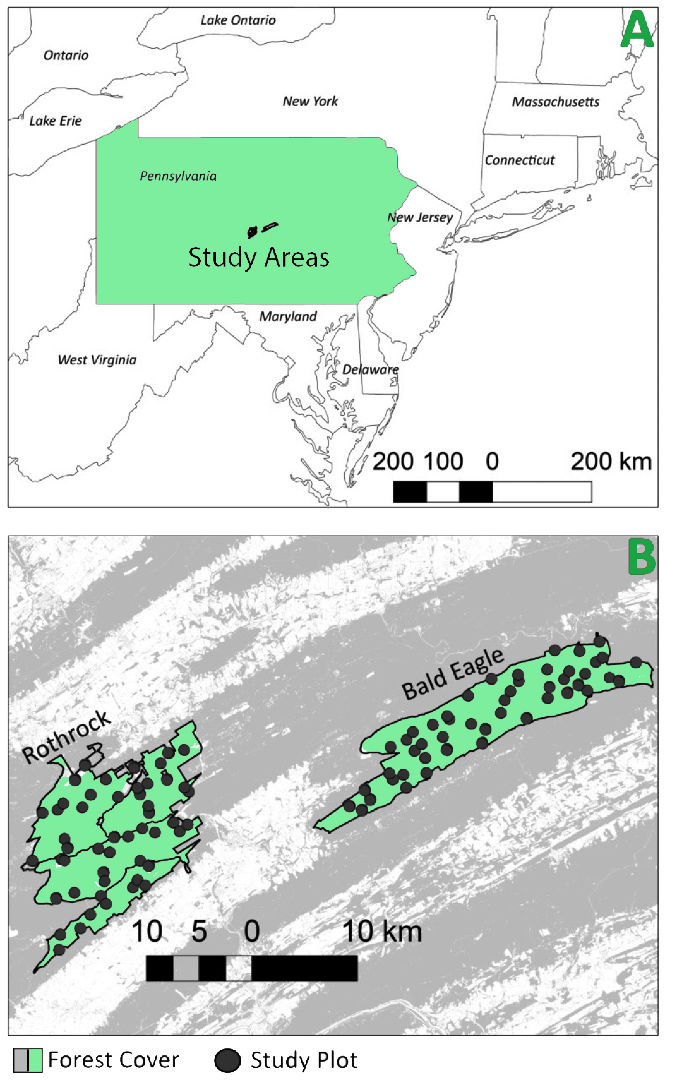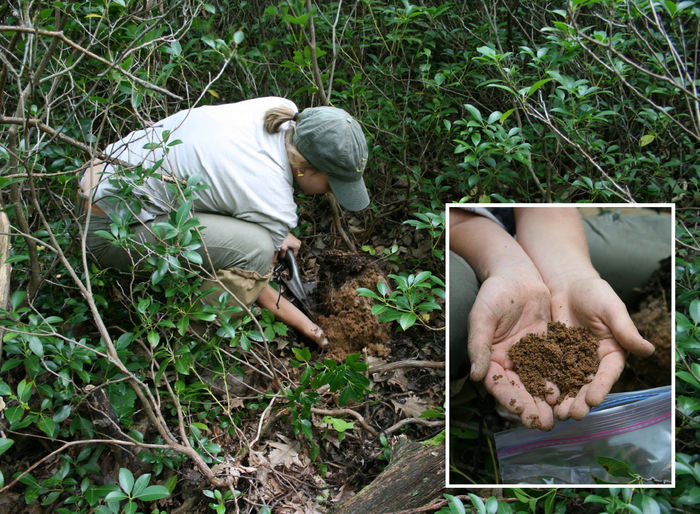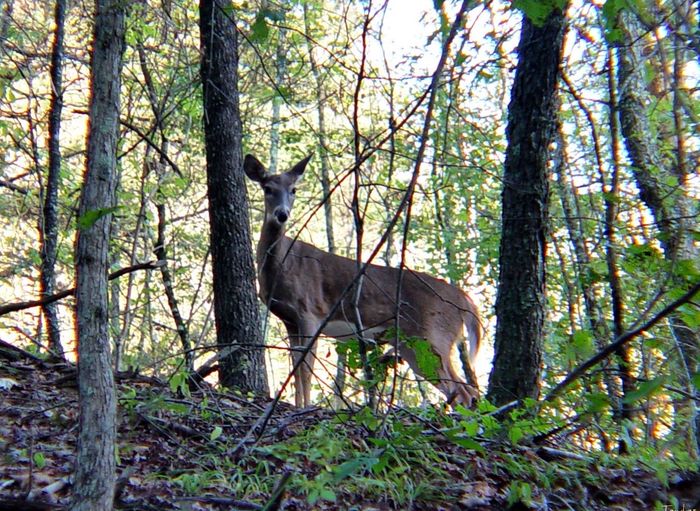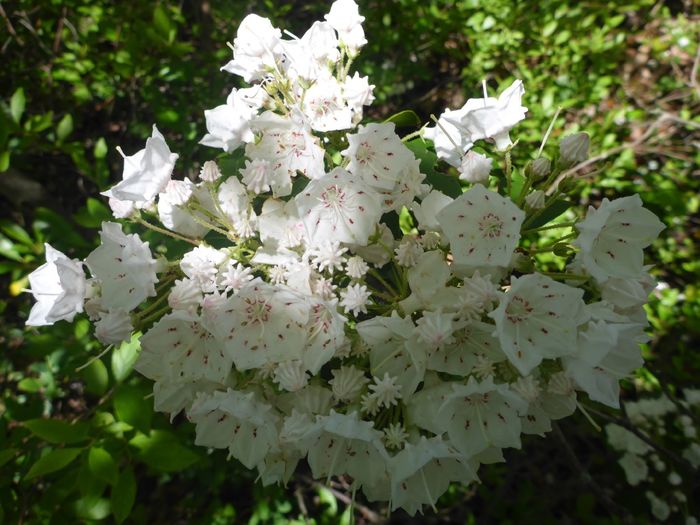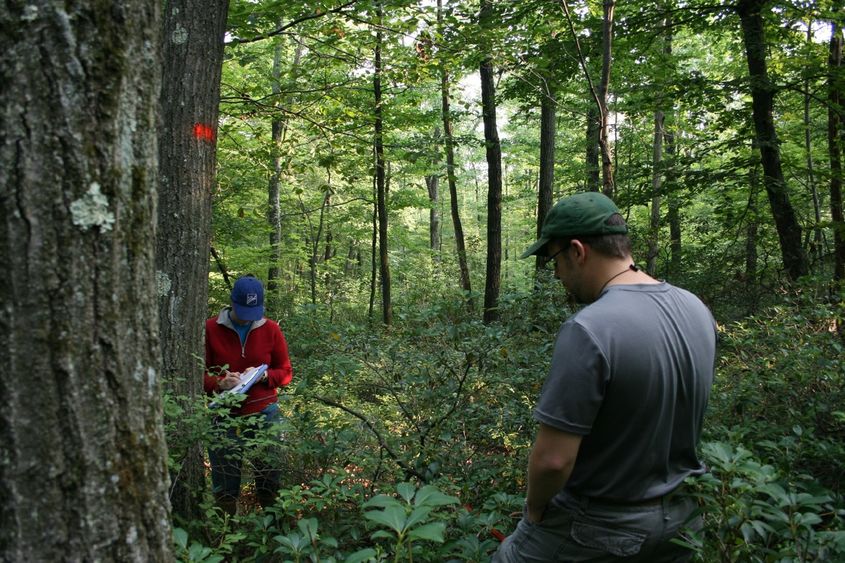
Study lead author Danielle Begley-Miller and a colleague collecting information about the number and height of tree seedlings at a research plot.
UNIVERSITY PARK, Pa. — New findings from long-term research underscore the challenges managers face when trying to conserve Penn’s Woods.
The seven-year study, conducted by a team of researchers from Penn State, the Pennsylvania Game Commission and Pennsylvania Department of Conservation and Natural Resources is the first to simultaneously assess how deer browsing, soil nutrients and competing vegetation affect tree regeneration in Keystone State forests.
In findings recently published in Canadian Journal of Forest Research, researchers highlighted the complexity of determining what limits forest tree regeneration. After conducting an extensive, manipulative experiment in two state forests in central Pennsylvania, researchers found that regeneration outcomes were strongly influenced by the initial abundance of tree seedlings, deer and soil pH.
In the study, the researchers monitored the number and height of tree seedlings at 24 sites for seven years. At each site, 11 permanent plots received different combinations of fencing to exclude deer, dolomitic lime applications to restore soil nutrients and non-selective herbicide broadcast to reduce competing vegetation, such as mountain laurel.
The researchers reported three primary findings:
- Deer-exclusion fencing resulted in the greatest increase in growth in areas with initial low seedling abundance, but all treatments had a positive effect on seedling growth and abundance.
- Soil pH can help predict seedling success. When soil pH was greater than 4.6 — increased from lime applications — seedling growth and abundance in unfenced control areas with higher initial seedling abundance was comparable to the fenced-only areas.
- Herbicide treatments made the least difference to regrowth. Seedling abundance only increased on herbicide-treated plots on less acidic — pH greater than 4.6 — sites with initial low seedling abundance. These increases were not as great as fencing under the same conditions. Competing vegetation, which the researchers said they assumed to be a symptom of excessive, long-term deer herbivory, did not seem to be a primary factor limiting tree regeneration in the study areas.
This research was unique in that it assessed multiple factors affecting forest regeneration, noted the study’s lead author, Danielle Begley-Miller, postdoctoral researcher in Penn State’s College of Agricultural Sciences.
“Many individual studies have documented how deer browsing, soil nutrition and dominant understory species — like fern and mountain laurel — can hinder growth of tree seedlings,” she said “However, few studies have looked at more than one factor at a time.”
Forest and deer managers are dealing with an incredibly complex system, she added.
“Our study gives us a peek at that complexity, and although it doesn’t offer a simple solution to conserving and managing our forests, it does indicate which deer- and forest-management actions are most effective under different forest conditions,” Begley-Miller said.
The research, begun in 2013, was conducted in Bald Eagle and Rothrock state forests and focused on Pennsylvania’s most iconic landscape — the oak-hickory forests in the Ridge and Valley Region. Mountain laurel, the abundant state flower, has been thought to compete with tree seedlings, according to study co-author Marc McDill, associate professor of forestry at Penn State.
“But the study did not find that mountain laurel was a significant inhibitor of tree seedlings,” he said.
The most important finding was the interaction between fencing and soil pH, according to Begley-Miller.
“On our most acidic plots, where soil pH was less than 4 and no lime was added, fencing to exclude deer was necessary to increase seedling abundance,” she said. “On less acidic sites, the magnitude of the fencing effect decreased compared to the other treatments.”
In plots with very few seedlings — about one seedling every 10 square feet — fencing was the only treatment that increased seedling abundance, regardless of soil pH, Begley-Miller added.
Nearly all plots in the forests had a pH less than 4 prior to the liming treatment, the result of natural soil acidification and prior acid rain. Previous Penn State and U.S. Department of Agriculture Forest Service research has shown that soil pH in Pennsylvania has declined by one unit over 40 years. This decline in pH reduces plant nutrients like calcium and magnesium available in the soil and allows toxic metals, such as aluminum and manganese, to be taken up by plants, reducing their growth, the researchers noted.
The lime treatment in the study increased soil pH by an average of one unit while adding calcium and magnesium to replace these losses, explained study co-author Autumn Sabo, assistant professor in biology at Penn State Beaver.
“This study sheds light on how deer impacts may change with soil pH and reiterates that deer management is critical for protecting tree regeneration given current soil conditions,” Sabo said.
Also contributing to the research at Penn State were Duane Diefenbach, professor of wildlife ecology, U.S. Geological Survey; Patrick Drohan, professor of pedology; and Phillip Jones, research associate in the Department of Ecosystem Science and Management; and Emily Domoto, Pennsylvania Department of Conservation and Natural Resources, Bureau of Forestry; and Christopher Rosenberry and Bret Wallingford, Pennsylvania Game Commission.
The Pennsylvania Game Commission and the Pennsylvania Department of Conservation and Natural Resources, Bureau of Forestry funded the research.
